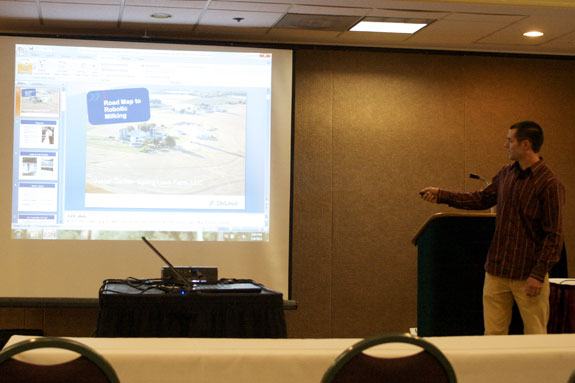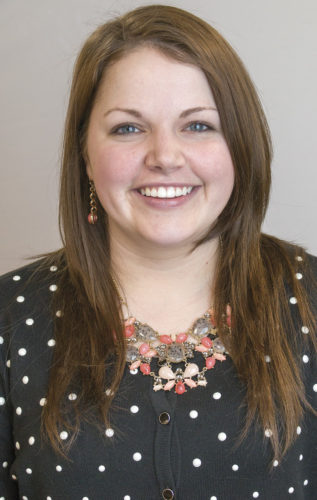This article was #11 of the Top 25 most well-read articles on www.progressivedairy.com in 2012. to jump to the article. It was published as /MORE content from February 11, 2012 issue. Click here for the full list of the Top 25. The 2012 Pennsylvania Dairy Summit featured two speakers about robotic milking. Josiah Garber of Spring Lawn Farms in Lancaster, Pennsylvania, and Daniel Wolf of Maple Lawn Farms in Lyons, New York, each discussed their family’s decision to install robotic milkers and some of the challenges that went along with it.
We asked both Garber and Wolf:
Q. Based upon your experience with robotic milkers, would you implement any other robotic equipment on your farm?
The success of robotic technology in any sector of society hinges on the following aspects: the ability to apply sensor technology and computer programing with robust components that can perform consistently up to 24 hours per day. Labor hours should be reduced and quality standards maintained or improved to display effectiveness.
As a result, we continue to evaluate our labor needs and quality standards to look for ways to improve. Some concepts we are looking into are automatic calf feeders, TMR mixing and delivery, precision farming (GPS) and an on-farm milk lab for herd management (Herd Navigator from DeLaval).
—Josiah Garber, dairy producer, Pennsylvania
We also have the robotic feed pusher from Lely, and we’ve been pleased with that. High-quality labor is our most precious resource, and one of the best things about robots is that ICE doesn’t have to verify their green cards.
In the future, we’re looking to build a new calf facility, and automatic calf feeders will likely be part of that expansion. When we grew the herd, we didn’t factor in enough additional labor for calf care. We’re struggling to find quality people who are willing to work weekends, like we were with milking. People always ask us, “If you could do it over, would you still put in robots?” I always say, “In a heartbeat. It’s not perfect, but this is the best decision we made for us.”
—Daniel Wolf, dairy producer, New York

ARTICLE :
As Howard and Mary Jo Straub discussed in " Robots on a grazing dairy give Michigan couple ‘freedom’ ," more and more producers are finding a way to make a robotic milking system work on their operation. At the Pennsylvania Dairy Summit held last week in Lancaster, two Northeast producers shared their success and challenges with robots.
Josiah Garber of Spring Lawn Farms in Lancaster, Pennsylvania, is one of three generations operating his family's 290-cow dairy. With four DeLaval units, cows are milked an average of 3.1 times a day.
Garber has toured nearly 100 robotic milker operations across the globe, including farms in Denmark, the Netherlands, Germany and Canada. He went with DeLaval because of the focus on teat preparation and the customizable cow traffic options.
Daniel Wolf of Maple Lawn Farms in Lyons, New York, incorporated robots in 2008. His herd of 380 is milked with seven Lely robot units. He and son John made the decision to switch to robots when they realized they had outgrown their double-six flatbarn parlor and they wouldn't be able to cost effectively retrofit a pit parlor.
Q. Why robotic milkers?
GARBER : We thought automatic milking gave us the best opportunity to be most efficient with our cows. It's 24-hour milking, so you're consistently getting a return on your investment.
WOLF : Our labor costs were too high. It wasn't that we were paying too much for our labor; it just took too many man hours to milk the way we were set up. We had Hispanic labor but had an experience where the employees we thought were legal were not. We learned that ICE doesn't question the robots' green cards.
Q. What have been some of your biggest challenges?
GARBER : Figuring out other chores. When we were milking in a parlor, we'd switch out bedding during milking time. We had to figure out when and how to maintain stalls in the robot system. Sometimes we had to move the cows out and other times we were able to work while they were there.
WOLF : We've learned it's not about how many cows you milk, it's how many pounds of milk can that robot harvest in a 24-hour period. Every time we tried to push cow numbers on a robot, the frequency of milking went down and the pounds of milk produced on that robot went down. There's a glass ceiling to how many cows a robot should be milking.
Q. How do you train cows on the robot?
GARBER : We take two people to fetch a cow, walk her through the Smart Gate, train her on the robot, then walk her five revolutions: down the feed alley, through the one-way gate, up the stall alley, through the Smart Gate, then through the robot.
WOLF : We took the approach of a slaughterhouse or a sale stable. Where you want the cow to go, she needs to not feel threatened about getting there, until she gets to the point where she can't back out. We've trained all the cows without injury to the cow or to a person.
Q. What do producers need to consider before switching to robots?
GARBER : Look at your cow flow. Determine how you're going to encourage them to go through the robot. It's a true paradigm shift from chasing the cows to the parlor two or three times a day to 'How can we make this so the cows want to come here three times a day to get milked?' It takes a different mindset.
WOLF : If you're considering robots, find other farms to visit. There's enough of us now that you don't have to travel very far to see robots. If you find a farm you like, ask lots of questions and go back four or five times to make sure you understand all that goes into setting it up.
Both Garber and Wolf spoke about how the qualify of life has improved dramatically since switching to robots. Wolf is able to spend more time with his grandchildren, while Garber enjoys summertime waterskiing with his wife and her family. PD
Related resources:
- Visit Lely's profile on Proud to Dairy to see robotic milkers in action, and hear from robotic milker owners, like Jacob Knigge in the video below.
- See photos and additional information on milking technologies in the article, " DeLaval showcases four progressive operations during bus tour"

Emily Caldwell
Web Editor
emily@progressivedairy.com





